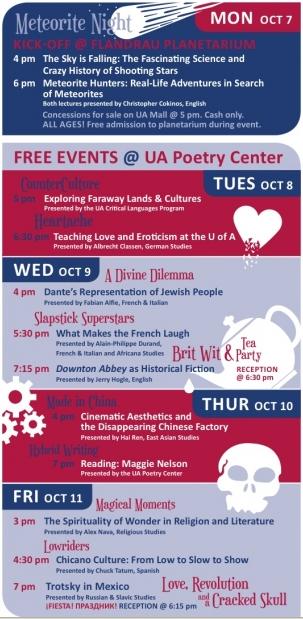Last Saturday went to two art events. First, to the Davis Dominguez Gallery1 for a reception for Small Things Considered. Great show – you must see it (May 7-June 27)! These are just a few of the over 80 artists represented.
Below, a cunningly framed photographic print by Regina Heitzer-Momaday and the next by Carrie Seid, silk stretched over copper, which she bends into curves. Her description (emphasis mine) follows:
The pieces are constructed using a hardwood base, cut and formed sheet metals (copper, brass and aluminum), and silk. The metal forms an understructure which supports a stretched layer of silk. Modulated color (in the form of under-painting or dyed silk) is sometimes used to enhance depth, structure and dimension. The additional step of oiling the fabric “skin” creates various degrees of translucence, allowing the outer layer to be visually penetrable – a watercolor rendered in three dimensions.
 A marvelous dish of clay by Gary Benna. (You must click on it to see the detail of the bodies in the center.) Oil on paper by Danielle Neibling.
A marvelous dish of clay by Gary Benna. (You must click on it to see the detail of the bodies in the center.) Oil on paper by Danielle Neibling.


My absolute favorite, Golden Doves on Cholla Ribs by Thomas Kerrigan, done in clay! And this bronze jackrabbit by Mark Rossi. You may have seen his javelina in the entry to the Desert Museum.
One of my favorite artists, Gail Marcus Orlen, has done this oil (which includes the bird), and one of our CAS members, Barbara Jo, has created More Filipinos Than Fish (photographed in front of handwoven linen by another CAS member, Claire Campbell Park; both women taught at Pima).
An oil by another CAS member, Moira Geoffrion, from a photo which she took when we were in Venice, and cast glass by Katja Fritzsche, whose studio we (CAS) had recently visited2.

Another piece of art that I wish I could afford, this Nest by Phil Lichtenhan in metal with ceramic eggs.
After that reception a few of us went to the Raices Taller 222  gallery for a dance performance by ZUZI! Dance4 to conclude the Mujeres, Mujeres, Mujeres exhibit. A snippet from their website:
gallery for a dance performance by ZUZI! Dance4 to conclude the Mujeres, Mujeres, Mujeres exhibit. A snippet from their website:
The Guerrilla Girls5, a women’s artist coalition, has discovered that only 3% of the artists in the Metropolitan Museum’s modern art sections are women and that 90% of the solo exhibitions were of work by white male artists.3

 The gallery was small, so we squished against the walls to allow the dancers room. This woman’s tats were distinctive.
The gallery was small, so we squished against the walls to allow the dancers room. This woman’s tats were distinctive.
Crazy Weather
Tucson has had unusual weather this June. May was beautiful, with high temperatures 78°-83°, then you blinked, and while your eyes were closed, it was 93°, and when the blink was finished, in June, it was 103°. Reminded me a a young child playing hopscotch, jumping over the squares with stones in them. Last week we got a bit of rain and the temperatures abated slightly (to the 90’s). Night before last another splatter of rain (if you scratch the dirt, you can see the dampness is  only 1/8” thick) and it has “cooled” to the high 80’s.
only 1/8” thick) and it has “cooled” to the high 80’s.
A month and a half ago the palo verdes had bloomed6. With this unusual rain they’re blooming again. And my agapanthus look great.
Birds crash into my windows at this time of the year because their brains aren’t fully functional during mating season. And I have a flycatcher who has been attacking his reflection in the window for a few days. Same reason.
1http://davisdominguez.com/
2https://notesfromthewest.wordpress.com/2015/05/28/art-and-the-desert/
3www.raicestaller222.org/CurrentExhibition.htm
4http://www.zuzimoveit.org/dancecompany/upcomingshows.html
5http://www.guerrillagirls.com/
6https://notesfromthewest.wordpress.com/2015/04/22/earth-day/

















